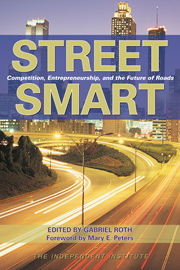Rep. Frank Wolf, Virginia Republican and a leading advocate of the so-called Dulles Connector, now urges Virginia state authorities to “dispatch a team of national transportation experts to rework the proposal ... to address major federal concerns that threaten to torpedo the project.”
“The project has come too far “ and is far too important to allow it to collapse at the eleventh hour,” he told U.S. Transportation Secretary Mary Peters in a letter.
One does not have to be a national transportation expert to offer a simple solution to this problem, a solution that would provide area residents the needed service at about a third of the cost: Instead of building a costly new rail line, create a bus corridor, or “Busway,” in the median of the existing Dulles Airport Access Road, with spurs to Tyson’s Corner, Reston and Herndon.
A busway would have the following advantages:
- Unlike the proposed trains, which would have to stop at every station, a system of buses and minibuses traveling at frequent intervals on a dedicated, congestion-free busway would give users fast, direct access to the airport from the Beltway and Route 66.
- Airport passengers with luggage could be picked up at or taken to their homes by minibus, without having to negotiate Metro stations.
- Tyson’s Corner and other congested areas could be served by circulating buses, coming straight off the busway, without requiring passengers to transfer at stations and without an expensive tunnel or unsightly elevated railroad tracks.
- Existing users of the Dulles Toll Road would not have their tolls raised to finance a railroad that few of them would use.
- The lower costs would enable the Federal Transit Administration to support the project and still have funds to support other “New Starts” in its program.
- Competitive bus services would help hold down passenger fares, which would require no taxpayer subsidy.
- Riders on Metro’s Orange Line, which is expected to be running at full capacity by 2010, would be spared the additional congestion resulting from the Dulles rail extension.
Bus travel is not highly regarded in the United States, possibly because it is associated with dilapidated vehicles providing slow service on congested urban streets, while surface and subway trains move on dedicated rights-of-way, unimpeded by traffic. A dedicated busway, however, would give buses a similar advantage, in addition to being able to leave the busway to pick up and deliver passengers close to their points of origin and destinations, as is already being done on Northern Virginia’s Shirley Highway bus lanes on I-395. Passengers would not have to use “feeder” bus services to get to trains. As for comfort, the buses, large and small, could be outfitted to any luxury standard for which users would be willing to pay.
The maximum traffic forecast for the Dulles rail connector is less than 9,000 passengers per hour. These could be carried in comfort in 200 buses with 45 seats each or 600 minibuses with 15 seats each, or some combination thereof.
An unimpeded highway lane can carry 1,000 buses (or 2,000 cars) an hour, so a busway would have plenty of spare capacity at all times. If desired, this excess capacity could be used to accommodate other high-occupancy vehicles, as is already being done on the Shirley Highway. Alternatively, this capacity could accommodate toll-paying vehicles, with tolls collected electronically and set at levels to ensure free traffic flow at all times. Such lanes have been operating successfully since 1995 on State Route 91 east of Los Angeles, and are expected to be added by 2013 to Virginia segments of the Washington Beltway.
It is not often that superior service can be provided at lower cost, but a busway would do just that. How about it, Mr. Wolf?








